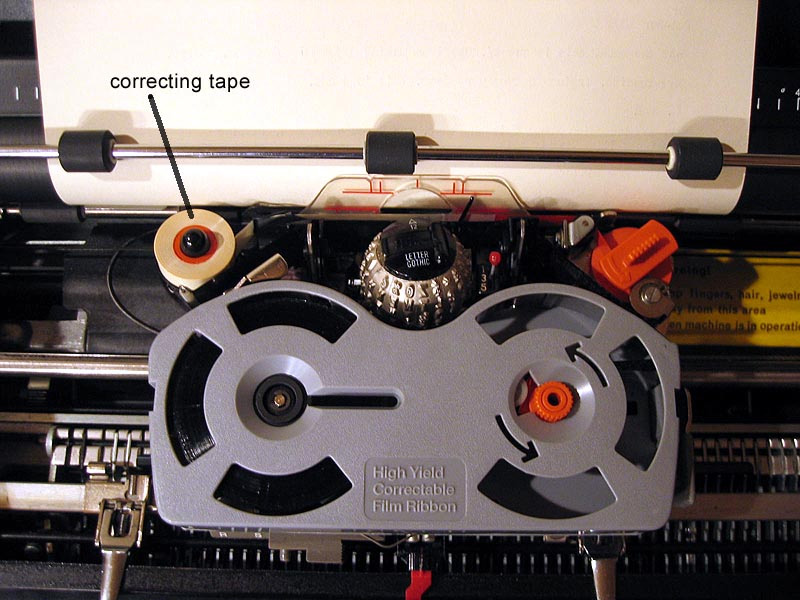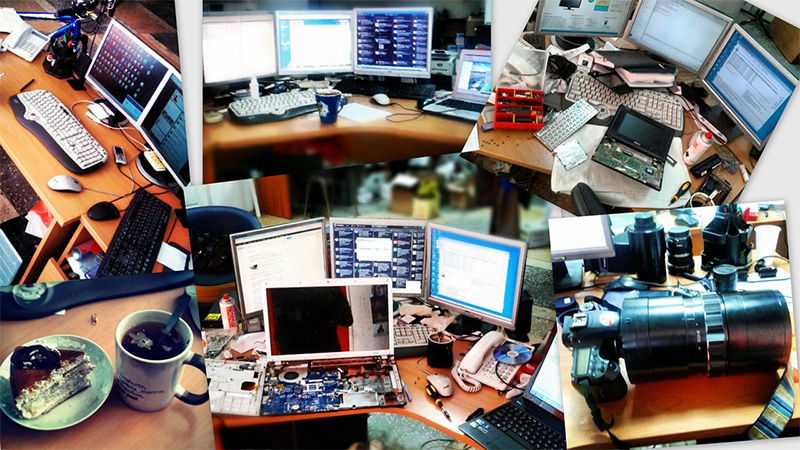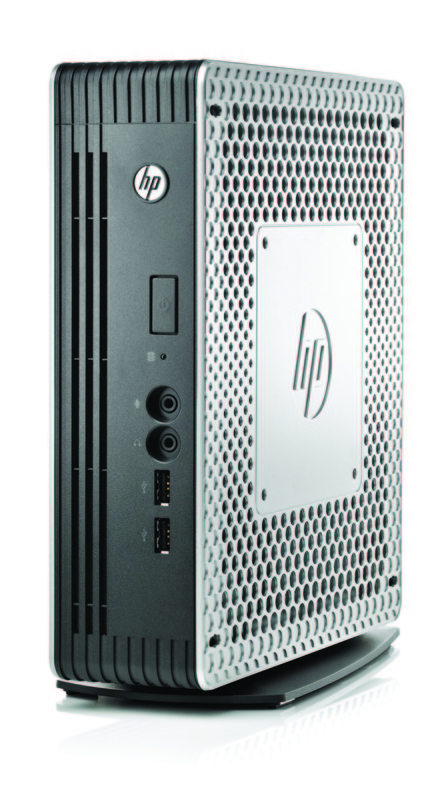01 - Virtualization of jobs. What is it and what to eat
As we promised in the announcement post , we open a series of articles on virtualization of the workspace.
The theme is “fashionable” in the west, and it has been developed for a long time, both technologically (software) and in terms of hardware. If you have heard of words such as “thin clients,” “virtualization,” “bring your own device,” “remote access to data,” then you most likely have heard of any part of this vast sea of workplace virtualization. .
And, before delving into the study of this topic, perhaps it is worth holding a small educational program and answering the simplest questions in order to streamline the pieces of information that some readers already have in their heads. Well, those who are already “in the subject line”, we think, will also be interested in reading, what if you learn something new, or do you see the problem from a different angle?
')
So, workplace virtualization. What is she like? Before answering this question, we suggest you to think in general about the term “workspace” itself and such a phrase as “workplace virtualization”.
From the point of view of IT, of course, the first associations will be with the desktop computer (and the desktop, both physical and “virtual”, which is offered by your operating system). And it is the virtual desktop (system) that is an excellent example of how the workplace is virtualized. On the desktop are the active (current) documents, programs that you are working with at the moment, and the multitasking of the OS and a convenient file system simplify your work.
Thirty years ago instead of Word'a on the desktop (real) could well have been a typewriter

(and well, if it was some fashionable Selectric from IBM, with the function of removing typos).

Instead of the application "calculator" - its "desktop" analog, connected to a wall outlet or standalone. Instead of Google search, a thick stack of folders, numbered by year (or letters of the alphabet). Instead of the address book of the mail client - a telephone directory and a stack of envelopes. Instead of CAD / CAE systems - a set of drawing accessories and technical documentation. Well, that was a little earlier ... it is better not to remember.

Thanks for the picture mikejum , he has an interesting post dedicated to accounts.
Now all these paper-hardware complexes are moved inside computers, and computers themselves (and even mobile phones) are comparable in price to wooden furniture from IKEA. Compare the complexity of the production of the chair, and, say, the CPU on the process of 45 nanometers. But their cost is comparable, and, sometimes, differs not by 10-20 times, but by 2-3. And, nevertheless, the workplace still often looks far from refined promotional materials without wires, power, in horse-spherical conditions in a vacuum; and on our desks there are still documents, writing materials, there is a telephone, but who knows what else?

Surely almost everyone on the table not only a computer, but also other items of office life.
What distinguishes the virtualization process that has been going on for the past 100 years from the current process? Scale and speed. Virtualization of the workplace today is the transfer of your computer (and all its applications) to the “virtual” state, and it is performed in the same way as in the past, the “hardware” assistants of office employees received their digital counterparts, after which they ended up in museums.
If earlier virtualization is stermalized to untie you from a set of specific things, nowadays virtualization of workplaces is a way to untie you from a specific computer hardware. Instead of a large, space-consuming system unit, there is a small box, about the size of a home router, or a monoblock monitor.

Instead of a 350 watt power supply, a small and economical power supply, like a notebook, does not require active cooling. Instead of separate places for accountants, engineers and managers - universal jobs, ready to work at any time. All programs, data and settings - on the server, the hardware of which is designed for constant loads, has a four-nine reliability coefficient, and the software intelligently distributes the available resources among active users. Idle computer engineer does not help to save on electricity or speed up the work of his neighbor. Virtualization of workplaces (current reading) solves these and many other problems. Moreover, the deployment of new workstations and expansion takes minutes against hours in the “classic” case. And instead of the “inconvenient” computer, you can use your usual laptop or tablet with a docking station and an external monitor. And most importantly - within the company from almost any computer, you can access your documents, files and applications in seconds, while not being afraid of any potential data leakage, or tolerance violations, or potential holes in the protection of someone else's computer. No files, no data, or anything of any value is stored on the client.
By itself, “virtualization” is divided into two large categories, radically different in the way the user interacts with the server:
The access tools are two main technologies:
Both approaches have both strengths and weaknesses, but before talking about them, you need to understand how they differ.
VDI - virtual desktop infrastructure - a software and hardware complex that works as follows: there is a server with a server OS, on which “images” with client OSes run. Some of the files are common, some of them are separate, but the point is that each user has his own image of the operating system, and access to it is provided (as a rule, but there are exceptions from the rules) through thin clients. On a thin client, there is either a special version of Windows (with the Embedded prefix) that allows you to connect to the server and work with the “OS image”. which is stored on the server, or a very small operating system, the only purpose of which is to load hardware and basic drivers, search for and connect to the server and output the virtual desktop to your monitor.
RDP / RDS - remode desktop protocol / remote desktop services - a hardware and software system that works differently than VDI. The main difference is that the server operating system is your working environment: all programs run directly on the server (inside its OS), and through the RDP protocol you get access to specific applications or a user desktop, but there is no “image” with your there is no personal OS on the server, maximum is a folder with a user profile and data / documents. Access via the RPD protocol requires its support on the client side, which imposes certain restrictions on both server and user technologies.
The advantage of VDI over RDS is an isolated workspace for users and greater freedom in choosing the software and hardware of both servers and user devices. Also, the VDI approach provides greater operational reliability and is slightly easier to configure and use.
The RDS approach can save your money on software licenses (no need to purchase a separate Hypervisor, since its functionality is already built into the server OS), requires slightly less hardware server resources, allows you to implement interesting software solutions for collaboration of several specialists on one project, but imposes the appropriate restrictions in view of a single OS for all connected users and has disadvantages directly deriving from its merits.
Performance with a large number of connections will be lower than that of the VDI solution, tuning and implementation is more difficult, and the number of connections can be limited not only by the hardware capabilities of the server hardware, but also programmatically, at the OS or application level.
We will also tell you more about each of the approaches, their strengths and weaknesses, with examples, pictures and a full set of everything that a good article on Habré can't do without. In the meantime, back to the virtualization of jobs, there is something else that needs to be mentioned before moving on.
There is another current trend and the associated type of virtualization. This is about BYOD (“bring your own device”, “drag your piece of hardware”) and application virtualization.

The implementations of BYOD 'a are a mass, starting with sponsoring the purchase of the hardware you want to work with (laptop, monoblock or some other device), ending with bonuses in monetary terms, if you bring your own device or work on the remote, appearing in the office only when it is really necessary.
For an employer, BYOD is advantageous in that it is not spent on the purchase of workstations, but it gives the opportunity to choose the employee himself on what to work. Typically, IT departments are well aware of their needs and are able to embody them most accurately, independently selecting the necessary hardware. For a BYOD user, it is advantageous because he uses familiar and convenient tools, a favorite keyboard with a familiar arrangement of symbols and function keys, a mouse that sits “like a glove” in his hand, and so on.
Application virtualization “projects” the application you need from the server to your device, transparently for you or in a separate “window” with the desktop, depending on the implementation. All data and work files can be stored simultaneously in two places, in encrypted storage on the local device and in the storag on the server, and access to applications and data can be obtained not only from a laptop or home computer, but also from a tablet or phone. This approach has many different implementations, different approaches that are responsible for the safety and security of data, authorization methods, accessibility from mobile devices and much more, it combines both a large number of advantages and significant disadvantages (security department BYOD and departments especially related to confidential information).
With basic concepts of virtualization of workplaces, as well as with current trends in this area, it seems, we have finished. Do you have any questions? Got something to add? Had experience working with “virtual women”? Want to share your impressions? We are waiting for you in the comments!
UPD from 22 Apr 2012: We launched a special project on Habré, which was described in the zero post of this season. It is located at: habrahabr.ru/special/hp/commercial and there is a lot of interesting information, the form of feedback we promised, as well as a test of knowledge in the field of virtualization. We are waiting for you and your questions!
The theme is “fashionable” in the west, and it has been developed for a long time, both technologically (software) and in terms of hardware. If you have heard of words such as “thin clients,” “virtualization,” “bring your own device,” “remote access to data,” then you most likely have heard of any part of this vast sea of workplace virtualization. .
And, before delving into the study of this topic, perhaps it is worth holding a small educational program and answering the simplest questions in order to streamline the pieces of information that some readers already have in their heads. Well, those who are already “in the subject line”, we think, will also be interested in reading, what if you learn something new, or do you see the problem from a different angle?
')
So, workplace virtualization. What is she like? Before answering this question, we suggest you to think in general about the term “workspace” itself and such a phrase as “workplace virtualization”.
From the point of view of IT, of course, the first associations will be with the desktop computer (and the desktop, both physical and “virtual”, which is offered by your operating system). And it is the virtual desktop (system) that is an excellent example of how the workplace is virtualized. On the desktop are the active (current) documents, programs that you are working with at the moment, and the multitasking of the OS and a convenient file system simplify your work.
Thirty years ago instead of Word'a on the desktop (real) could well have been a typewriter

(and well, if it was some fashionable Selectric from IBM, with the function of removing typos).

Instead of the application "calculator" - its "desktop" analog, connected to a wall outlet or standalone. Instead of Google search, a thick stack of folders, numbered by year (or letters of the alphabet). Instead of the address book of the mail client - a telephone directory and a stack of envelopes. Instead of CAD / CAE systems - a set of drawing accessories and technical documentation. Well, that was a little earlier ... it is better not to remember.

Thanks for the picture mikejum , he has an interesting post dedicated to accounts.
Now all these paper-hardware complexes are moved inside computers, and computers themselves (and even mobile phones) are comparable in price to wooden furniture from IKEA. Compare the complexity of the production of the chair, and, say, the CPU on the process of 45 nanometers. But their cost is comparable, and, sometimes, differs not by 10-20 times, but by 2-3. And, nevertheless, the workplace still often looks far from refined promotional materials without wires, power, in horse-spherical conditions in a vacuum; and on our desks there are still documents, writing materials, there is a telephone, but who knows what else?

Surely almost everyone on the table not only a computer, but also other items of office life.
What distinguishes the virtualization process that has been going on for the past 100 years from the current process? Scale and speed. Virtualization of the workplace today is the transfer of your computer (and all its applications) to the “virtual” state, and it is performed in the same way as in the past, the “hardware” assistants of office employees received their digital counterparts, after which they ended up in museums.
If earlier virtualization is stermalized to untie you from a set of specific things, nowadays virtualization of workplaces is a way to untie you from a specific computer hardware. Instead of a large, space-consuming system unit, there is a small box, about the size of a home router, or a monoblock monitor.

Instead of a 350 watt power supply, a small and economical power supply, like a notebook, does not require active cooling. Instead of separate places for accountants, engineers and managers - universal jobs, ready to work at any time. All programs, data and settings - on the server, the hardware of which is designed for constant loads, has a four-nine reliability coefficient, and the software intelligently distributes the available resources among active users. Idle computer engineer does not help to save on electricity or speed up the work of his neighbor. Virtualization of workplaces (current reading) solves these and many other problems. Moreover, the deployment of new workstations and expansion takes minutes against hours in the “classic” case. And instead of the “inconvenient” computer, you can use your usual laptop or tablet with a docking station and an external monitor. And most importantly - within the company from almost any computer, you can access your documents, files and applications in seconds, while not being afraid of any potential data leakage, or tolerance violations, or potential holes in the protection of someone else's computer. No files, no data, or anything of any value is stored on the client.
What can virtualization today, and what technologies are used in the industry?
By itself, “virtualization” is divided into two large categories, radically different in the way the user interacts with the server:
- Sever-Based Computing - server in the “cloud”;
- Central-Based Computing - server in the office.
The access tools are two main technologies:
- Workplace virtualization, also known as VDI ;
- Remote Desktop, abbreviated - RDP or RDS .
Both approaches have both strengths and weaknesses, but before talking about them, you need to understand how they differ.
VDI - virtual desktop infrastructure - a software and hardware complex that works as follows: there is a server with a server OS, on which “images” with client OSes run. Some of the files are common, some of them are separate, but the point is that each user has his own image of the operating system, and access to it is provided (as a rule, but there are exceptions from the rules) through thin clients. On a thin client, there is either a special version of Windows (with the Embedded prefix) that allows you to connect to the server and work with the “OS image”. which is stored on the server, or a very small operating system, the only purpose of which is to load hardware and basic drivers, search for and connect to the server and output the virtual desktop to your monitor.
RDP / RDS - remode desktop protocol / remote desktop services - a hardware and software system that works differently than VDI. The main difference is that the server operating system is your working environment: all programs run directly on the server (inside its OS), and through the RDP protocol you get access to specific applications or a user desktop, but there is no “image” with your there is no personal OS on the server, maximum is a folder with a user profile and data / documents. Access via the RPD protocol requires its support on the client side, which imposes certain restrictions on both server and user technologies.
The advantage of VDI over RDS is an isolated workspace for users and greater freedom in choosing the software and hardware of both servers and user devices. Also, the VDI approach provides greater operational reliability and is slightly easier to configure and use.
The RDS approach can save your money on software licenses (no need to purchase a separate Hypervisor, since its functionality is already built into the server OS), requires slightly less hardware server resources, allows you to implement interesting software solutions for collaboration of several specialists on one project, but imposes the appropriate restrictions in view of a single OS for all connected users and has disadvantages directly deriving from its merits.
Performance with a large number of connections will be lower than that of the VDI solution, tuning and implementation is more difficult, and the number of connections can be limited not only by the hardware capabilities of the server hardware, but also programmatically, at the OS or application level.
We will also tell you more about each of the approaches, their strengths and weaknesses, with examples, pictures and a full set of everything that a good article on Habré can't do without. In the meantime, back to the virtualization of jobs, there is something else that needs to be mentioned before moving on.
There is another current trend and the associated type of virtualization. This is about BYOD (“bring your own device”, “drag your piece of hardware”) and application virtualization.

The implementations of BYOD 'a are a mass, starting with sponsoring the purchase of the hardware you want to work with (laptop, monoblock or some other device), ending with bonuses in monetary terms, if you bring your own device or work on the remote, appearing in the office only when it is really necessary.
For an employer, BYOD is advantageous in that it is not spent on the purchase of workstations, but it gives the opportunity to choose the employee himself on what to work. Typically, IT departments are well aware of their needs and are able to embody them most accurately, independently selecting the necessary hardware. For a BYOD user, it is advantageous because he uses familiar and convenient tools, a favorite keyboard with a familiar arrangement of symbols and function keys, a mouse that sits “like a glove” in his hand, and so on.
Application virtualization “projects” the application you need from the server to your device, transparently for you or in a separate “window” with the desktop, depending on the implementation. All data and work files can be stored simultaneously in two places, in encrypted storage on the local device and in the storag on the server, and access to applications and data can be obtained not only from a laptop or home computer, but also from a tablet or phone. This approach has many different implementations, different approaches that are responsible for the safety and security of data, authorization methods, accessibility from mobile devices and much more, it combines both a large number of advantages and significant disadvantages (security department BYOD and departments especially related to confidential information).
With basic concepts of virtualization of workplaces, as well as with current trends in this area, it seems, we have finished. Do you have any questions? Got something to add? Had experience working with “virtual women”? Want to share your impressions? We are waiting for you in the comments!
UPD from 22 Apr 2012: We launched a special project on Habré, which was described in the zero post of this season. It is located at: habrahabr.ru/special/hp/commercial and there is a lot of interesting information, the form of feedback we promised, as well as a test of knowledge in the field of virtualization. We are waiting for you and your questions!
Source: https://habr.com/ru/post/175213/
All Articles